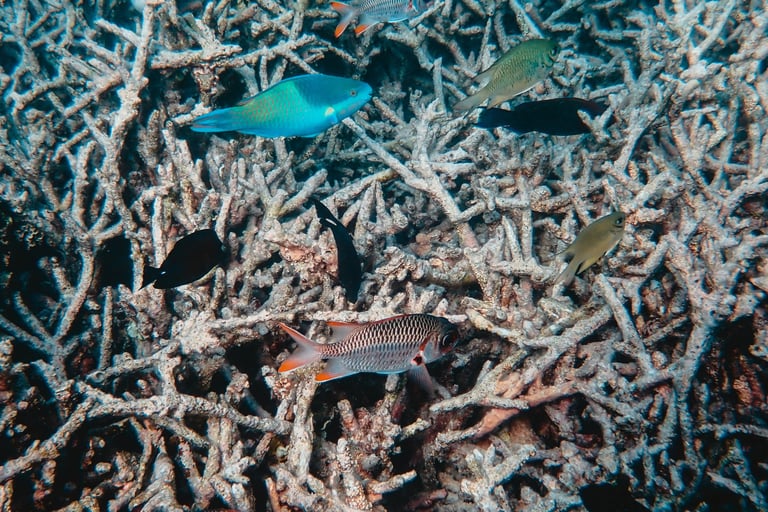What Happens to Your Sunscreen in the Ocean?
Discover how sunscreen ingredients like oxybenzone and octinoxate impact coral reefs and marine life. Learn why mineral sunscreens and protective clothing matter for ocean conservation.
PRESERVING OUR GREAT LAKES AND OCEANS


What Happens to Your Sunscreen in the Ocean?
Sunscreen Wash-Off: A Threat to Marine Ecosystems
Each year, approximately 14,000 tonnes of sunscreen chemicals wash into the ocean—from both swimmers and wastewater runoff—even if the wearer never enters the sea. Coastal areas and coral reefs receive an estimated 4,000 to 6,000 tonnes annually.
These chemicals, especially organic UV filters found in chemical sunscreens such as oxybenzone and octinoxate, are toxic to coral even at extremely low doses—down to 62 parts per trillion. This tiny concentration, comparable to a drop of water in six Olympic pools, is enough to induce bleaching, DNA damage, deformities, endocrine disruption, and even coral death.
How Do Coral and Marine Life Suffer?
Once these chemicals enter the water, corals alter them into phototoxins—compounds harmless in darkness but lethal under sunlight, as shown in lab studies with sea anemones and corals. These toxins impair coral symbiotic algae, causing bleaching and increased disease susceptibility.
Besides corals, other marine organisms—such as algae, sea urchins, fish, dolphins, and even marine mammals—can absorb sunscreen residues, with some chemicals accumulating in tissue or disrupting growth and hormonal systems.
Why Mineral Sunscreens Are a Better Choice
Chemical sunscreens rely on synthetic UV filters (like oxybenzone or octinoxate) that harm coral and marine life. Mineral alternatives using zinc oxide or titanium dioxide offer physical sun protection and are considered safer for reefs—only when they use non-nano particles to avoid toxicity.
Even mineral sunscreens can be harmful if nanoparticles wash into coral-rich waters and generate hydrogen peroxide, another coral stressor.
How Communities Are Responding
Some regions have enacted protective bans. For instance, Palau banned sunscreens containing oxybenzone and several other harmful chemicals in 2020, while Hawaii followed suit in 2021. Bonaire and Thailand also restrict chemical sunscreens in marine national parks.
What You Can Do to Help Protect the Ocean
Choose mineral-based sunscreens with non-nano zinc oxide or titanium dioxide as the only active ingredients.
Avoid chemical UV filters entirely—especially oxybenzone, octinoxate, octocrylene, and parabens.
Skip aerosols and sprays, which drift and leave residues on sand that wash into the water.
Wear UV protective clothing such as rash guards to reduce sunscreen use by up to 90%.
Use shade, hats, and timed outdoor activity rather than relying on sunscreen alone.
Looking for a safer sunscreen option?
We recommend Stream2Sea Reef-Safe Sunscreen, which is biodegradable and tested to be gentle on coral reefs and marine life. You can find it listed under My Scuba Diving Gear Setup & Top Recommendations on our website for easy shopping and more eco-friendly dive essentials.
Happy and safe diving,
The ScubaBlast Team
National Park Service. (2022, October 5). Sunscreen impacts on coral reefs. Retrieved from https://www.nps.gov/subjects/oceans/sunscreen.htm
Ocean Foundation. (2018, May 24). Is your sunscreen killing the coral reef? Retrieved from https://oceanconservancy.org/blog/2018/05/24/sunscreen-killing-coral-reef/
The Truth About Corals and Sunscreen. (2022, September). Smithsonian Ocean. Retrieved from https://ocean.si.edu/ecosystems/coral-reefs/truth-about-corals-and-sunscreen
Coral Digest. (n.d.). Sunscreen and Coral. Retrieved from https://www.coraldigest.org/threats/sunscreen/index.html
Stanford Report. (2022, May 5). Corals and sea anemones turn sunscreen into toxins. Retrieved from https://news.stanford.edu/stories/2022/05/coral-killing-sunscreens
TIME / The Times. (2025, April 3). How to wear sunscreen without harming the ocean. Retrieved from https://www.thetimes.co.uk/article/how-wear-sunscreen-without-harming-ocean-times-luxury
Wikipedia. (n.d.). UV filter. Retrieved from https://en.wikipedia.org/wiki/UV_filter
REDDIT user insights. (2022, March). LPT: reef friendly sunscreen and swimwear. Retrieved from https://www.reddit.com/r/LifeProTips/comments/ta3vfp
"Disclosure: This post may contain affiliate links, meaning I get a commission if you decide to make a purchase through my links, at no cost to you."


